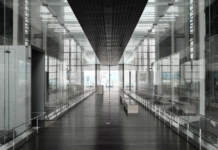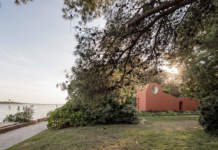Some themes, subjects, and areas are much influenced by the era, inevitably feeling the effects of broader issues of the day. Reflecting the expectations of the social and cultural environment around them, today‘s architects seem to pay minimal attention to sacred architecture, including churches, mosques, synagogues, temples, places for prayer and worship, which were historically the focus of cultural expressions. However, it was not so long ago, in Italy, that much was invested in the construction of the Grand Mosque of Rome – perhaps Paolo Portoghesi‘s most successful and important work. There was also the era of competitions put on by CEI for building new churches and the interest paid by institutions like the Venice Biennale, which celebrated the theme with its exhibition “Sacred Space in Modernity,“ not very many years ago, though it may seem like ages. The international architectural landscape seems to follow this same tendency. With the exception of a few sporadic examples – such as Tadao Ando‘s water temple and the church of the light in Japan, Rafael Moneo‘s cathedral in Los Angeles, and the large Padre Pio complex designed by Renzo Piano in Pietrelcina – the theme of sacred architecture has not garnered the interest of the best known and studied contemporary architects. There are many reasons for this common lack of interest, and the complexity of the question is probably beyond the scope of a magazine. Still, we can try to identify some of the reasons, quickly summing up the main aspects of this indifference that probably has to do with the ever-more-worrisome lack of communication in today‘s interreligious conversation. Of course, we will try to stay in the specific area of architecture, though it is very clear that the radicalization of conflicts, wars, terrorism, extreme fundamentalism, and blind racism have done nothing to help artistic innovations that can seem out of their element in the face of the enormity of events. Though it would be completely ingenuous to attribute a demiurgic or redeeming power to architecture, at least the academic community should avoid the error of underestimating the importance of its narrative and communicative capacity, as well as its instrumental one. To draw a parallel with a pressing current issue, we could say that if the architectural discipline can do nothing in the face of recent migration of thousands of people fleeing hunger and destruction, it can do much to develop housing models designed for the emergency situation and later phases of integrating and receiving migrants, independently from the usual supply logic of the market, obviously focused on profit. This system, which ghettoizes and isolates communities – it is now obvious to everyone – radicalizes those conflicts, creating the social and cultural environment of hate and rejection that costs much more than resolving it would. Likewise, in the area of religion, architecture as a discipline can do nothing faced with destructive, cathartic phenomena like those happening now. But it is certainly of no help to completely ignore the topic, if only from the limited angle of one‘s discipline, as living somewhere includes the right to worship and practice one‘s faith and religious customs. The academic community‘s scant interest for the cultural discussion on sacred space likely has different origins and reasons in the East and West, though ending in the same results. There is no doubt that, over the centuries, and particularly in the last few decades, sacred architecture has lost the position of absolute importance that it once had in communities and societies. Cities historically revolved around the cathedral, and in many squares of Europe, government buildings and churches dominated the city landscape architecturally. Of course, the church‘s power over society has been much diminished, and as a result, there is less need to express its power through architecture, which has found realms for innovation and expression in civil society instead. Sacred architecture also lost its expressive power with modernity; suffice to mention the criticism of Giulio Carlo Argan leveled against the Le Corbusier‘s Ronchamp Chapel, accusing it of being overly mystical and monumental to the point of betraying the very tenets of the father of the “machine à habiter,“ deriving from the logic of strict functionalism. Ultimately, the line of architectural thinking that had revolved around sacred architecture for centuries has been broken and has not offered new models equally able to stir deep aesthetic responses. The lack of sacredness in contemporary sacred spaces – which some say makes the relationship to prayer more familiar and personal – has actually impoverished and saddened spaces that were once splendid and noble. In Islamic cultures, though religion is the foundation of all of society‘s interests, a discussion of sacred architecture has not developed, likely because of the orthodoxy and intractability of traditional models, inhibiting innovation in architecture. We could say that sacred architecture‘s loss of central importance in Western culture, and the extreme role of religion in Muslim communities both impede the development of design ideas for sacred architecture, making less space for an ongoing, in-depth exploration of its design.
The architecture of sacred space and the search for a needed sacredness
area 147
| sacred grounds





